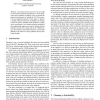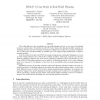ICRA
2010
IEEE
14 years 11 months ago
2010
IEEE
Abstract— Enabling mobile robots to assemble large structures in constrained environments requires planning systems that are both capable of dealing with high complexity and can ...
120
click to vote
ICRA
2010
IEEE
14 years 11 months ago
2010
IEEE
— Data collection using Autonomous Underwater Vehicles (AUVs) is increasing in importance within the oceanographic research community. Contrary to traditional moored or static pl...
114
click to vote
ICRA
2010
IEEE
14 years 11 months ago
2010
IEEE
Abstract— To compute collision-free and dynamicallyfeasibile trajectories that satisfy high-level specifications given in a planning-domain definition language, this paper prop...
104
click to vote
ICRA
2010
IEEE
14 years 11 months ago
2010
IEEE
Abstract— Trajectory planning and optimization is a fundamental problem in articulated robotics. It is often viewed as a two phase problem of initial feasible path planning aroun...
102
click to vote
CP
2010
Springer
14 years 11 months ago
2010
Springer
Generic SAT solvers have been very successful in solving hard combinatorial problems in various application areas, including AI planning. There is potential for improved performanc...
128
click to vote
ATMOS
2010
14 years 12 months ago
2010
To model and solve optimization problems arising in public transportation, data about the passengers is necessary and has to be included in the models in any phase of the planning...
128
click to vote
OIR
2007
15 years 15 days ago
2007
Purpose – This article is the third in a four-part series that aims to illustrate the process involved in planning a portal and creating a portal definition document. Design/me...
114
Voted
ROBOTICA
2002
2002
Point-to-Point trajectory planning of flexible redundant robot manipulators using genetic algorithms
15 years 19 days ago
: The paper focuses on the problem of point-to-point trajectory planning for flexible redundant robot manipulators (FRM) in joint space. Compared with irredundant flexible manipula...
103
click to vote
EXPERT
1998
15 years 20 days ago
1998
This article illustrates the complexities of real-world planning and how we can create AI planning systems to address them. We describe the IMACS Project (Interactive Manufacturab...
106
click to vote
IJRR
2002
15 years 20 days ago
2002
This paper presents two object manipulation planning methods based on fitted stratified and semi-stratified approaches using finger relocations. The problem is discussed in the fr...


